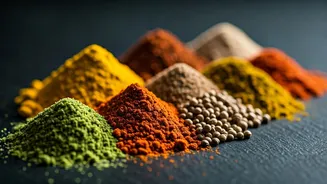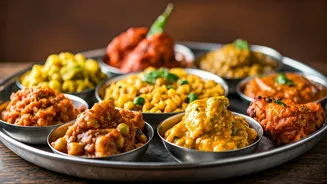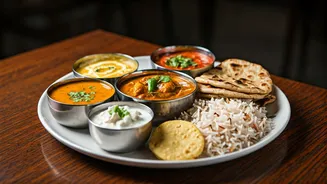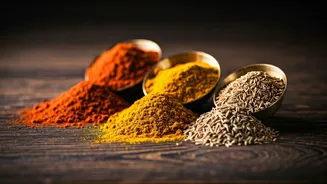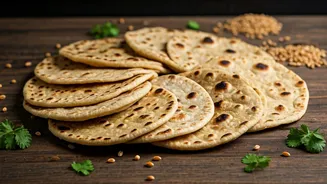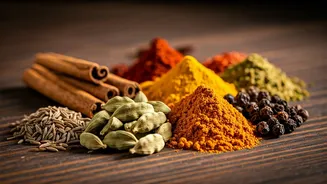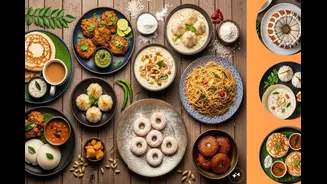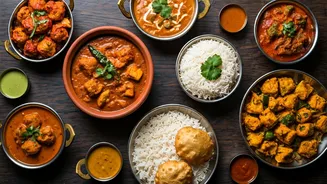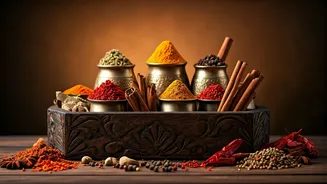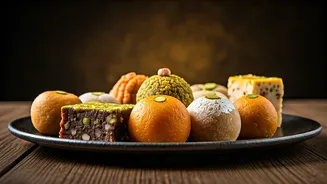A Culinary Canvas
Indian cuisine is an expansive, diverse tapestry, reflecting the nation's rich history and varied geographical regions. Each state, often each city, possesses
its unique culinary identity, shaped by local ingredients, traditional cooking methods, and cultural influences. For example, in the North, rich gravies and tandoor-cooked dishes take center stage, while the South boasts a vibrant array of rice-based preparations and seafood delicacies. The West features a blend of coastal flavors and influences from neighboring regions, and the East presents a spectrum of subtly spiced dishes. This incredible diversity isn't just about different dishes; it is a reflection of India's multi-faceted society, where every meal narrates a story, and flavors are as diverse as the people.
Northern Flavors Unveiled
Northern Indian cuisine is known for its creamy, rich curries and the extensive use of dairy products. Butter chicken, with its tender pieces of chicken simmered in a luscious tomato-based gravy, is a globally recognized dish. Another popular choice is Rogan Josh, a fragrant lamb curry originating from Kashmir, infused with aromatic spices like cardamom and cloves. Tandoori cooking, a legacy of the Mughal Empire, sees meats and vegetables marinated in yogurt and spices, then cooked in a clay oven. The breads of the North are also exceptional, with naan, roti, and paratha serving as the perfect complement to the flavorful curries and grilled dishes. This culinary heritage celebrates the abundance of the land and is a testament to the region’s rich history.
Southern Spice Route
The Southern part of India offers a different palate experience, with its emphasis on rice, lentils, and the use of coconut milk. Dosa, a crispy fermented crepe made from rice and lentils, is a favorite for breakfast or lunch, served with sambar (a lentil-based vegetable stew) and chutneys. Idli, steamed rice cakes, often accompanies it. Kerala's cuisine, influenced by its coastal location, uses seafood extensively, such as fish cooked in coconut milk and spices. Tamil Nadu's cuisine is known for its flavorful curries, such as the Chettinad chicken, rich with spices and chili. Andhra Pradesh offers fiery hot dishes, and Karnataka's cuisine features a variety of vegetarian and non-vegetarian preparations. The South's cuisine is a celebration of fresh ingredients, bold spices, and unique cooking styles.
Western Culinary Delights
Western India's cuisine reflects a blend of influences, shaped by its coastal proximity and historical interactions. Maharashtra, for example, is famous for its Pav Bhaji, a flavorful vegetable curry served with a buttered bun. Gujarat offers a sweet and savory vegetarian cuisine, with dishes like Dhokla (a steamed savory cake) and Undhiyu (a mixed vegetable casserole). Goan cuisine, influenced by Portuguese colonization, features dishes such as Vindaloo (a spicy pork curry) and seafood preparations, often cooked with vinegar and chili. The coastal regions use fresh seafood generously, combined with local spices. The flavors of Western India offer a captivating mix of influences, with bold spices and unique culinary techniques.
Eastern Culinary Journey
Eastern Indian cuisine distinguishes itself with subtle flavors and the extensive use of mustard oil. Bengal's cuisine is renowned for its fish preparations, with dishes like Macher Jhol (fish curry) and Hilsa fish dishes. Dishes are often accompanied by rice. Bihar's cuisine is known for its Litti Chokha (baked wheat balls served with mashed vegetables). Odisha's cuisine incorporates seafood and is subtly spiced. The Northeast region boasts a variety of unique dishes that reflect its diverse culture. The Eastern part also embraces the use of fermented foods and offers a light, unique culinary experience. The dishes are characterized by their intricate spice blends and the thoughtful use of regional ingredients, creating a tapestry of tastes that reflects the diversity of the land.
Street Food Gems
Indian street food is a culinary adventure in itself, offering a burst of flavors at every corner. From the bustling streets of Delhi to the coastal towns of Mumbai, street food is an integral part of Indian life. Aloo Tikki, a potato cutlet served with chutneys, is popular in the North. Pani Puri (golgappa), crispy hollow balls filled with flavored water, is a common snack across the country. Vada Pav, a potato fritter in a bun, is a famous Mumbai street food. Each region offers its unique street food specialties, using fresh ingredients. These affordable and delicious snacks provide a quick and flavorful experience, and they showcase the best of the local flavors of each region. It is a true testament to the accessibility and versatility of Indian cuisine.
Essential Ingredients
Indian cuisine uses a wide array of ingredients, each contributing to its unique flavors. Spices, such as turmeric, cumin, coriander, and chili, form the base of many dishes, bringing warmth and complexity. Lentils and pulses are a staple in vegetarian meals, providing protein and texture. Rice is the staple grain in most regions, with varieties ranging from basmati to local varieties. Vegetables and fruits, locally grown, are the base of many regional dishes, reflecting the diversity of the land. Dairy products, like ghee (clarified butter) and yogurt, contribute to the richness and creaminess of many preparations. Using fresh, seasonal ingredients is important for authentic Indian flavors. This focus on natural ingredients enhances the unique flavors of Indian cuisine.
Cooking Techniques Unveiled
The preparation methods used in Indian cuisine also contribute to its distinctive flavors. Stir-frying, deep-frying, and grilling are commonly used to create textures. Slow-cooking and simmering techniques help to meld flavors together in curries and stews. Tandoor cooking, using a cylindrical clay oven, imparts a smoky flavor to meats and breads. The skillful use of spices is also very important, since spices are often roasted or bloomed in oil. Fermentation is a prominent technique in preparing food, which gives sour and tangy flavors to dishes. The cooking techniques, combined with traditional methods, create unique food experiences. These processes are a testament to the time-honored methods used in Indian cooking.
Cultural Significance of Food
Food plays a central role in Indian culture, representing more than just nourishment. Meals are often social gatherings, bringing family and friends together to share food and conversation. Festivals and celebrations are marked by special dishes that symbolize traditions. The practice of offering food to deities (prasad) showcases the religious importance of food. Every region has its cultural practices around food, from the order in which meals are served to the specific dishes consumed at specific times of the year. Food reflects the values of hospitality, respect, and community in Indian society. The cuisine is deeply entwined with the cultural heritage of India, strengthening the bonds of families and communities.
Conclusion: Culinary Legacy
Indian cuisine is an enduring legacy, a testament to the nation's diverse culture and traditions. The incredible variety of flavors, ingredients, and cooking methods offers a journey for anyone to discover. From regional specialties to the vibrant street food scene, India's cuisine provides a complete sensory experience. It represents a living history, with food traditions passed down across generations. Whether it is a simple meal or an elaborate feast, Indian food continues to bring people together, celebrating the essence of Indian culture. It is a rich culinary tradition that continues to evolve, inspiring chefs and delighting food lovers from around the globe.
